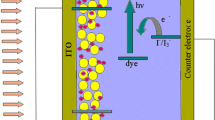Abstract
Nanocrystalline TiO2 thin films have been prepared by sol–gel dip coating method. The X-ray diffraction results showed that TiO2 thin films annealed at 400, 450 and 500 °C are of anatase phase and the peak corresponding to the (1 0 1) plane is present in all the samples. The grain size of TiO2 thin films was found to increase with increasing annealing temperature. The grain size is found to be 20, 26 and 38 nm for the films annealed at 400, 450 and 500 °C. TiO2 thin films were sensitized by natural dyes extract from red cabbage and blue pea. It was found that the absorption peak of red cabbage extract is at about 545 nm while that of blue pea extract is at around 576 and 622 nm respectively. The dye sensitized TiO2 based solar cell sensitized using red cabbage, exhibited a Jsc of 4.38 mA/cm2, Voc of 0.47 V, FF of 0.36 and η of 0.73 % and the solar cell sensitized using blue pea, exhibited a Jsc of 4.16 mA/cm2, Voc of 0.45 V, FF of 0.35 and η of 0.67 %. Natural dyes as sensitizers for dye sensitized solar cells are promising because of their environmental friendliness, low-cost production and designable polychrome modules.









Similar content being viewed by others
References
Chiba Y, Islam A, Watanabe Y, Komiya R, Koide N, Han LY (2006) Dye-sensitized solar cells with conversion efficiency of 11.1%. Jpn J Appl Phys 45:L638–L640
Hao Sancun, Wu Jihuai, Huang Yunfang, Lin Jianming (2006) Natural dyes as photosensitizers for dye-sensitized solar cell. Sol Energy 80:209–214
Go′mez-Ortı′z NM, Va′zquez-Maldonado IA, Pe′rez-Espadas AR, Mena-Rejo′n GJ, Azamar-Barrios JA, Oskam G (2010) Dye-sensitized solar cells with natural dyes extracted from achiote seeds. Sol Energy Mater Sol Cells 94:40–44
Calogero Giuseppe, Di Marco Gaetano (2008) Red Sicilian orange and purple eggplant fruits as natural sensitizers for dye-sensitized solar cells. Sol Energy Mater Sol Cells 92:1341–1346
Cherepy NJ, Smestad GP, Gratzel M, Zhang JZ (1997) Ultrafast electron injection: implications for a photoelectrochemical cell utilizing an anthocyanin dyesensitized TiO2 nanocrystalline electrode. J Phys Chem B 101:9342–9351
Smestad GP (1998) Education and solar conversion: demonstrating electron transfer. Sol Energy Mater Sol Cells 55:157–178
Dai Q, Rabani J (2002) Photosensitization of nanocrystalline TiO2 films by anthocyanin dyes. J Photochem Photobiol A 148:17–24
Rossetto M, Vanzani P, Mattivi F, Lunelli M, Scarpa M, Rigo A (2002) Synergystic antioxidant effect of catechin and malvidin 3-glucoside on free radicalinitiated peroxidation of linoleic acid in micelles. Arch Biochem Biophys 408:239–245
Markakis P (1982) Anthocyanins as food color. Academic Press, New York
Wongchareea Khwanchit, Meeyoo Vissanu, Chavadej Sumaeth (2007) Solar Dye-sensitized solar cell using natural dyes extracted from rosella and blue pea flowers. Sol Energy Mater Sol Cells 91:566–571
Kumara GRA, Kanebo S, Okuya M, Onwona-Agyeman B, Konno A, Tennakone K (2006) Shiso leaf pigments for dye-sensitized solid-state solar cell. Sol Energy Mater Sol Cells 90:1220–1226
Eiji Yamazaki, Masaki Murayama, Naomi Nishikawa, Noritsugu Hashimoto, Masashi Shoyama, Osamu Kurita (2007) Utilization of natural carotenoids as photosensitizers for dye-sensitized solar cells. Sol Energy 81:512–516
Senthil TS, Muthukumarasamy N, Velauthapillai Dhayalan, Agilan S, Thambidurai M, Balasundaraprabhu R (2011) Natural dye (cyanidin 3-O-glucoside) sensitized nanocrystalline TiO2 solar cell fabricated using liquid electrolyte/quasi-solid-state polymer electrolyte. Renew Energy 36:2484–2488
Terahara N, Oda M, Matsui T, Osajima Y, Saito N, Toki K, Honda T (1996) Five new anthocyanins, ternatins A3, B4, B3, B2 and D2, from Clitoria trenatea flowers. J Nat Prod 59(2):139–144
Kazuma K, Noda N, Suzuki M (2003) Flavonoid composition related to petal color in different lines of Clitoria ternatea. Phytochemistry 64:1133–1139
Kazuma K, Noda N, Suzuki M (2003) Malonylated flavonol glycosides from the petals of Clitoria ternatea. Phytochemistry 62(2):229–237
Bagchi D, Sen CK, Bagchi M, Atalay M (2004) Anti-angiogenic, antioxidant, and anti-carcinogenic properties of a novel anthocyaninrich berry extract formula. Biochemistry 69:75–80
Yoshida K, Mori M, Kawachi M, Okuno R, Kameda K, Kondo T (2003) A UV-B resistant polyacylated anthocyanin HBA, from blue petals of morning glory. Tetrahedron Lett 44:7875–7880
Ma Hongchao, Yue Lixia, Yu Chunling, Dong Xiaoli, Zhang Xinxin, Xue Mang, Zhang Xiufang, Fu Yinghuan (2012) Synthesis, characterization and photocatalytic activity of Cu-doped Zn/ZnO photocatalyst with carbon modification. J Mater Chem 22:23780–23788
Meng Fanke, Hong Zhanglian, Arndt James, Li Ming, Zhi Mingjia, Yang Feng, Wu Nianqiang (2012) Visible light photocatalytic activity of nitrogen-doped La2Ti2O7 nanosheets originating from band gap narrowing. Nano Res 5:213–221
Fernando JMRC, Senadeera GKR (2008) Natural anthocyanins as photosensitizers for dye-sensitized solar devices. Curr Sci 95:663–666
Sheng Meng, Jun Ren, Efthimios Kaxiras (2008) Natural dyes adsorbed on TiO2 nanowire for photovoltaic applications: enhanced light absorption and ultrafast electron injection. Nano Lett 8(10):3266–3272
de Faria Emerson Henrique, Marçal Alex Lemes, Nassar Eduardo José, Ciuffi Katia Jorge, Calefi Paulo Sergio (2007) Sol-Gel TiO2 thin films sensitized with the mulberry pigment cyanidin. Mater Res 10(4):413–417
Buraidah MH, Teo LP, Yusuf SNF, Noor MM, Kufian MZ, Careem MA, Majid SR, Taha RM, and Arof AK TiO2/Chitosan-NH4I(+I2)-BMII-based dye-sensitized solar cells with anthocyanin dyes extracted from black rice and red cabbage. doi:10.1155/2011/273683
Calogero G, DiMarco G, Caramori S, Cazzanti S, Argazzi R, Bignozzi CA (2009) Natural dye senstizers for photoelectrochemical cells. Energy Environ Sci 2:1162–1172
Author information
Authors and Affiliations
Corresponding author
Rights and permissions
About this article
Cite this article
Gokilamani, N., Muthukumarasamy, N., Thambidurai, M. et al. Utilization of natural anthocyanin pigments as photosensitizers for dye-sensitized solar cells. J Sol-Gel Sci Technol 66, 212–219 (2013). https://doi.org/10.1007/s10971-013-2994-9
Received:
Accepted:
Published:
Issue Date:
DOI: https://doi.org/10.1007/s10971-013-2994-9




